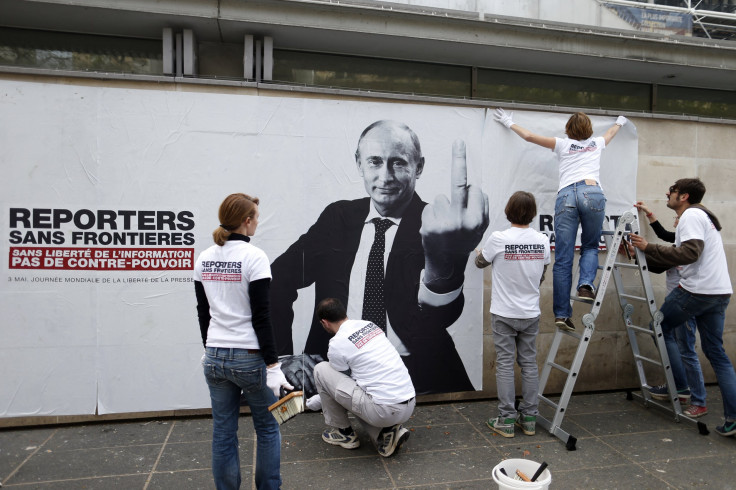Dissecting America's Low Press Freedom Ranking And The Situation Abroad

The United States was ranked 46 in the world by Reporters Without Borders (RSF) for press freedom on Wednesday. It's a noticeable drop from its spot at 32 in 2013, but there is far more to be learned from the RSF's Press Freedom Index than just a numbered rank.
RSF began releasing their Press Freedom Index in 2002. RSF's secretary-general Christophe Deloire says the Index is based on "the level of abuses, the extent of pluralism, media independence, the environment and self-censorship, the legislative framework, transparency and infrastructure."
RSF sends out a questionnairre to "partner organizations (18 freedom of expression NGOs located in all five continents), to our network of 150 correspondents, and to journalists, researchers, jurists and human rights activists." Along with state-sanctioned press suppression, the RSF incorporates general Internet freedoms and pressure from independent (usually militant) groups on journalists into the final score of a country.
The more suppression of the press, the higher the score. RSF's complete methodology and formula can be read here.
America's 46 ranked spot is a 13-position drop from 2013. The U.S. dropped four points in the Reporters Without Borders 100-point ranking system over the last year to an all-time low of 22 points. RSF ranked the U.S. lower in 2006, 2007 and their combined 2011/2012 indexes, but there was a major change in the U.S. ranking system in 2013.
From 2003 to 2012, the RSF had separate rankings for press freedom in the domestic U.S. and press freedom for "extraterritorial" regions (Iraq and Afghanistan). They combined these two rankings in 2013 and 2014. From 2011/2012 to 2013, the combined U.S. ranking rose to 32, but its press freedom score dropped four points.
That means while the U.S. ranking improved, press freedom was actually tightened, both in the U.S. and worldwide, where lowering scores paved the way for the U.S. to move up in the rankings.
RSF primarily cites the NSA/Snowden scandal for the drop in the U.S.'s ranking and says "the hunt for leaks and whistleblowers serves as a warning to those thinking of satisfying a public-interest need for information about the imperial prerogatives assumed by the world’s leading power," largely contribute to the drop in rank. The UK dropped three ranks itself for it's pressure on the Guardian, Glenn Greenwald and David Miranda.
The graphs above and below indicate general volatility of the U.S.'s press freedoms. As the War on Terror escalates through 2007, so does the U.S.'s score. A brief rising of freedoms comes with the election of President Barack Obama, who was predicted to curb some of the Bush administration's hard-line policies, but as the years passed it became clear that the press faced increasing difficulty. The sharp fall from 20 in 2010 to 47 in 2011/12 is a direct result of the arrests of journalists covering the Occupy movements.
Overall, the Press Freedom Index's annual global indicator measured a 1.8 percent rise in global violations of freedom of information, from 3,395 to 3,456 points. RSF reports that "alarmed by the Arab Spring turmoil, authoritarian regimes in the Arabian Peninsula and Central Asia have stepped up media censorship and surveillance to head off any 'attempt at destabilization.'"
Press freedoms have been dropped in all regions, except Asia-Pacific:
European Union and Balkans: 17.6 (17.5 previous year)
Americas: 30.3 (30.0)
Africa: 35.6 (34.3)
Asia-Pacific 42.2 (42.2)
Eastern Europe and Central Asia: 45.5 (45.3)
Middle East and North Africa: 48.7 (48.5)
The RSF Press Freedom Index is not without fault however. The formula has changed over the last 14 years. In 2012, changes to the questionnaire allowed countries to earn negative scores, meaning exceptionally good press freedoms. Beginning in 2013, the index questionnaire no longer included questions on human-rights violations against journalists and media organizations. Instead, RSF is separately investigating the topic via its network of sources.
Still, the RSF numbers are generally indicative of press freedoms across the world. In the years to come, provided RSF solidifies a regular formula for the Index, it can be used to gauge not only journalistic freedom across the world, but also political, economic and social volatility in the 21st century, as is clear in the graphs on graphs above on US rankings.
RSF provides in depth analysis of each of their annual indexes, 2014's can be found here. You can also download their data tables for each of the last 12 years and see each list here.
© Copyright IBTimes 2024. All rights reserved.






















